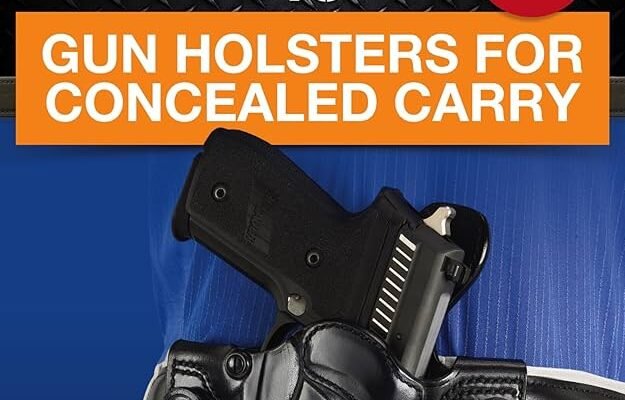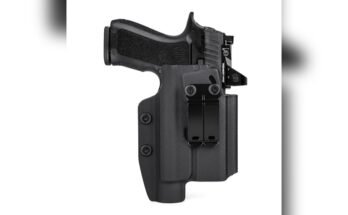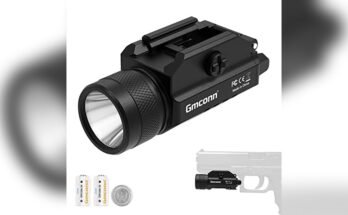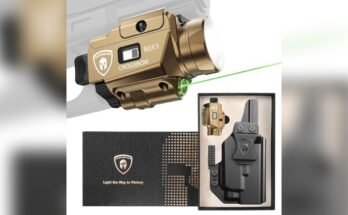I have carried with ankle holsters on long days, in offices, and on road trips. I have also coached new carriers through their first week with ankle carry. Here is the truth. Are ankle holsters practical for daily use? Yes, in the right context, with the right gun, and with solid training. But they are not the best choice for everyone. In this guide, I share what works, what fails, and how to decide if ankle carry fits your life. I will keep the language simple and the advice honest, with the main keyword used in plain ways so it feels natural.
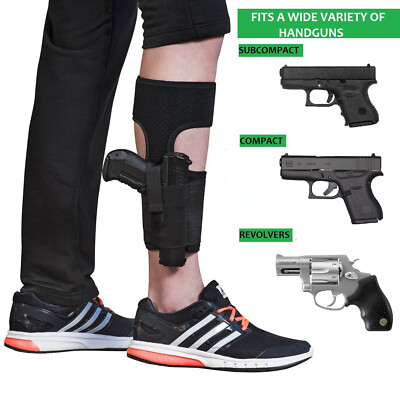
Source: www.ebay.com
What Is An Ankle Holster And Who Uses It?
An ankle holster is a rig that wraps around your lower leg. It holds a compact or subcompact pistol near the inside of your ankle. Many plain-clothes officers use it for a backup gun. Many civilians use it when belt carry prints or feels uncomfortable. Think business wear, medical scrubs, or a long drive. It shines when you sit a lot. It struggles when you run a lot.
In my early years, I used ankle carry at a desk job with dress clothes. It stayed hidden. I could access it while seated. But I learned fast that it is slower to draw while standing.

Source: www.falcoholsters.com
Pros Of Ankle Carry For Daily Use
Ankle carry solves real needs for many people. Here are the key benefits.
- Deep concealment. Your pant leg hides the outline well. It is hard to spot, even at close range.
- Comfort in a chair. The gun sits clear of your waist. Long drives and office hours feel better.
- Good as a second gun. It gives you a backup if your main gun fails or is blocked.
- Access when seated or on the ground. If you are in a booth, car, or kneeling, the ankle can be easier to reach than a belt.
- Seasonal flexibility. Works well with winter pants and boots. It avoids light summer shirts that print around the waist.
In my day-to-day, ankle carry beat appendix carry when I drove for hours. My hip did not ache, and the gun did not press into the seatbelt.

Source: www.shootingillustrated.com
Cons And Limitations You Must Weigh
There are clear trade-offs. You should know them before you choose ankle carry.
- Slower draw when standing. Studies show ankle draws take more time than waist draws. Expect a longer path to reach the gun and clear the pant leg.
- Movement limits. Sprinting, climbing stairs, or grappling can make access hard.
- Smaller guns only. You will carry a small 9mm or 380 ACP most of the time. That limits capacity and shootability.
- Retention risks. Poor holsters can bounce or shift. Bad straps can fail in a run.
- Clothing demands. Pants must be wide enough at the cuff. Tight hems will fight your draw.
- Environmental exposure. Dust, dirt, and sweat at floor level increase. You must clean more often.
From my testing, the average draw from ankle carry took about one to two seconds longer for me than AIWB. Your numbers may vary. Dry practice helps, but physics still matters.

Source: www.ebay.com
Fit, Firearm Choice, And Clothing Considerations
A good match of gun, holster, and pants can make ankle carry work well.
- Gun size. Subcompact 9mm or 380 ACP with a short barrel is common. Keep it light. Around 20 ounces loaded or less feels best on the ankle.
- Holster build. Look for firm support, a stable wrap, and a soft liner. Shearling or neoprene reduces rub. A thumb break or strong retention ride helps.
- Placement. Most right-handed users carry on the inside of the left leg. It keeps the grip tucked and helps the draw.
- Pants and socks. Choose boot-cut or straight-leg pants with enough opening. Use a tall, snug sock to reduce chafing.
- Shoes. Stable shoes reduce flop. Loose shoes make the rig feel heavy.
I learned to test pants at home. Sit, squat, and kneel. If the hem binds, pick a different pair.
Training, Safety, And Draw Speed
Safety first. The muzzle points near your foot and the floor. Good habits matter.
- Practice the clear-and-grip. Use your support hand to pull the pant hem high. Then get a full firing grip before the draw.
- Use safe angles. Keep your finger off the trigger until you are on target. Avoid sweeping your own leg on the way up.
- Seated drills. Work draws from a chair and from a vehicle. Seatbelts change your motion plan.
- Standing drills. Practice stepping back or kneeling as you draw to cut time and improve access.
- Reload plan. Pocket a spare magazine where you can reach it fast. An ankle reload is hard.
Independent tests and instructor courses often show that kneeling can speed an ankle draw. It shortens the reach and improves control. Timed practice supports this. Aim for clean reps, not only speed.
Maintenance, Hygiene, And Comfort Tips
Your ankle lives near dust and grit. Sweat also builds up. Keep things clean.
- Daily wipe-down. Use a light cloth to remove lint and dust from the gun and holster.
- Weekly deep clean. Check for rust, salt, and debris in the sights, barrel crown, and mag well.
- Rotate legs. If one ankle gets sore, switch sides for a few days.
- Use a barrier. A tall athletic sock reduces hot spots and rub.
- Fit checks. Re-tighten straps after a few hours of wear. Fabrics settle and can loosen.
On hot days, I swap to a breathable holster pad. It keeps skin calm and reduces odor.
Legal And Policy Factors
Check your local laws and any workplace rules.
- Permit rules. Some states demand a permit for concealed carry. Others have permitless carry. Follow your state code.
- Prohibited places. Many places ban firearms. Know the list. Courts, schools, and some private venues have rules.
- Duty to inform. Some states require you to tell officers you are armed if stopped while driving.
- Employer policy. Your job may limit carry. Many healthcare and corporate sites have strict bans.
- Transport rules. If you remove the holster in a car, keep safe handling rules in mind.
Stay updated. Laws change. Policy shifts can be quick and strict.
Real-World Scenarios: When It Shines And When It Fails
From my own use and from student feedback, ankle carry works best in set cases.
It shines when:
- You sit for long blocks of time. Office work, long commutes, or rideshare driving.
- You need deep concealment. Tight dress codes or social settings where printing is a concern.
- You carry a second gun. It adds redundancy on the opposite side of your body.
It struggles when:
- You expect to run, climb, or fight. Access is slower under stress while standing.
- You wear skinny or tapered pants. The hem blocks the draw.
- You need a duty-size gun. Weight and size will not work on the ankle.
I once tried a long trail walk with an ankle rig. After a mile, the weight swing annoyed me. I moved to a pocket holster for that use. Lesson learned.
Verdict: Are Ankle Holsters Practical For Daily Use?
Here is the short answer. Ankle holsters are practical for daily use if your day is seated, your pants allow access, your gun is small and light, and you train for the draw. They are less practical if you stand, move fast, or want a larger gun. Many people find them ideal as a backup. Some find them perfect for driving days. Few find them best for every day in every role.
Do a 30-day test. Track comfort, speed, concealment, and any hot spots. If your times improve and your carry stays stable, ankle carry may be your best fit.
Frequently Asked Questions
Is Ankle Carry Safe For Beginners?
Yes, with a quality holster and good training. Keep your finger off the trigger. Do slow dry practice before live fire. Avoid sweeping your leg during the draw.
What Guns Work Best For Ankle Holsters?
Small, light pistols. Think slim 9mm or 380 ACP with short barrels. Polymer frames help. Keep weight low to reduce bounce.
How Fast Can You Draw From An Ankle Holster?
It is slower than belt carry for most people. Expect about a second or two more at first. With practice, you can cut that down. Seated or kneeling draws are faster than standing.
Will An Ankle Holster Hurt My Ankle Or Knee?
It can if it is heavy or loose. Use a padded wrap and a tall sock. Rotate legs if sore. If pain stays, change holsters or carry method.
Can I Run With An Ankle Holster?
You can, but it is not ideal. Use strong retention and a light gun. Expect more movement and check the fit often.
Does Ankle Carry Work With Slim Pants?
Not well. You need a wider cuff. Boot-cut or straight-leg pants give you room to draw.
Is Ankle Carry Good As A Primary Method?
It can be for some seated jobs or deep concealment needs. Many prefer it as a backup. Test it in your daily routine to know for sure.
Conclusion
Ankle holsters can be a smart daily tool when your life fits their strengths. They hide well. They feel good when you sit. They demand small guns and solid practice. Weigh your day, your clothes, and your skills. Then choose with care. Try a short test, log your results, and keep what works.
If this helped, subscribe for more carry guides, leave a comment with your setup, or ask a question. Your feedback shapes future tests and tips.
Watch This Video on Are ankle holsters practical for daily use?
